
| Updated On - Nov 9, 2024
CLAT 2024 UG Question Paper Set A with Answer Key and Solution PDF is available for download. The exam was conducted by the Consortium of NLUs on December 3, 2023. Candidates were required to answer a total of 120 objective-type questions carrying 1 mark each covering five major sections: English Language, Current Affairs & General Knowledge, Legal Reasoning, Logical Reasoning and Quantitative Techniques.
CLAT 2024 UG Question Paper with Answer Key and Solution PDF Set A
| CLAT 2024 UG Question Paper with Answer Key PDF (Set A) | Download PDF | Check Solution |
CLAT UG 2024 Questions with Solution (Set A)
| Question No. | Question | Options | Correct Answer | Explanation |
|---|---|---|---|---|
| 1 | In contemporary literature, how is the relationship between character and setting described in the passage? | (A) Non-existent; characters and settings are separate entities. (B) A complex interplay where the setting influences plot and character. (C) Characters and settings are interchangeable. (D) Settings are insignificant in literature. |
(B) | The passage describes the setting as a vital part that influences plot and character development. |
| 2 | In The Namesake by Jhumpa Lahiri, what does the barren desert landscape symbolize? | (A) A thriving community. (B) The protagonist’s sense of isolation. (C) A lush, vibrant setting. (D) A happy, carefree life. |
(B) | The desert mirrors Gogol's isolation and identity struggles. |
| 3 | What role do the Scottish moors play in Shakespeare’s Macbeth? | (A) Beautiful, serene landscape. (B) No influence on characters. (C) An omen of impending tragedy. (D) A place for relaxation. |
(C) | The moors create an eerie atmosphere symbolizing the tragedy looming over characters. |
| 4 | What does the term "interplay" refer to in the passage? | (A) A lack of interaction. (B) A complex relationship where setting influences narrative. (C) Insignificant connection. (D) Complete separation. |
(B) | “Interplay” signifies the influence of setting on plot and character. |
| 5 | Which of the following best describes the setting in The God of Small Things? | (A) Boring. (B) Lush and vibrant. (C) Insignificant. (D) Dark and foreboding. |
(B) | The Kerala backwaters are described as lush and vibrant, crucial to the narrative. |
| 6 | What is the main theme discussed in the passage? | (A) Characters are not influenced by settings. (B) Setting is unimportant in literature. (C) Settings influence characters as much as other characters. (D) Settings have no role in character development. |
(C) | The setting can be as influential as characters in shaping narratives. |
| 7 | What is the central thesis of the above extract? | (A) Untouchability takes various forms. (B) Rich and poor have different ideas of justice. (C) Case management doesn’t affect judicial performance. (D) Protecting livelihoods opposes ease of doing business. |
(B) | The passage contrasts the justice experiences of the middle class and the poor. |
| 8 | What does "docket-excluded" refer to? | (A) Lack of access to justice for the poor. (B) Exclusion of bail for the poor. (C) Rejection of judicial system by the poor. (D) Exclusion of the rich from prisons. |
(A) | "Docket-excluded" means lack of easy access to justice for the poor. |
| 9 | Which word best describes the experience of different segments with the justice system? | (A) Symbiotic (B) Affective (C) Conflicting (D) Inter-dependent |
(C) | Different segments have conflicting experiences with the justice system. |
| 10 | What does the author imply about the judicial system? | (A) Reflects power relationships. (B) Access is based on wealth. (C) Made for the rich. (D) None of the above. |
(A) | The justice system reflects the same power dynamics as society. |
| 11 | What statement is the author most likely to disagree with? | (A) Representative democracy ensures interests of the poor in the judiciary. (B) Law ensures equality in text and practice. (C) The poor suffer most at the hands of touts. (D) All of the above. |
(B) | The author implies that in practice, the law does not ensure equality for marginalized groups. |
| 12 | What makes judicial reform of administration a ‘neutral’ area? | (A) Agreement across socio-economic classes. (B) Political consensus on reform. (C) Reforms do not favor any class. (D) Constitution mandates judicial reform. |
(C) | Administrative reforms are neutral because they benefit all without favoring specific groups. |
| 13 | What does the protagonist’s preference for “barrenness” and “starkness” suggest? | (A) Enjoys vibrant environments. (B) Values simplicity. (C) Prefers lush landscapes. (D) Seeks constant stimulation. |
(B) | The protagonist values simplicity, indicated by her preference for stark surroundings. |
| 14 | What does the protagonist’s reaction towards the postman reveal? | (A) Gratitude for his presence. (B) Dislikes disturbance. (C) Suspicion of others. (D) Indifference to others. |
(B) | Her cold stare shows she dislikes interruptions to her solitude. |
| 15 | What does the protagonist’s desire to be mistaken for a tree signify? | (A) Desire for societal appreciation. (B) Admiration for nature’s beauty. (C) Feels superior to others. (D) Yearns for unity with nature. |
(D) | She wishes to blend with nature, symbolizing a longing to escape her human identity. |
| 16 | What does the protagonist’s description of nestlings’ screams as “shrill and maddening” reveal? | (A) Finds it soothing. (B) Views nestlings as symbols of life. (C) Finds them vexing. (D) Feels protective of them. |
(C) | Words like “shrill and maddening” indicate her irritation towards the nestlings. |
| 17 | What best describes the protagonist’s state of mind in Carignano? | (A) Constant restlessness and anguish. (B) Isolation and disconnection. (C) Only isolation. (D) Contentment and peace. |
(D) | She feels peace and contentment in Carignano, enjoying her solitude. |
| 18 | What role does nature play in the protagonist’s life at Carignano? | (A) A source of creativity. (B) Offers solace and belonging. (C) Reminder of harsh life realities. (D) Source of distraction. |
(B) | She finds peace and belonging in the natural environment of Carignano. |
| 19 | Who is often regarded as the greatest playwright in the history of the English language? | (A) Jane Austen (B) William Wordsworth (C) William Shakespeare (D) George Orwell |
(C) | William Shakespeare is celebrated as a pivotal figure in English literature. |
| 20 | Which of Jane Austen’s novels is known for its social commentary and witty portrayal of romance? | (A) Nineteen Eighty-Four (B) Sense and Sensibility (C) I Wandered Lonely as a Cloud (D) The Rime of the Ancient Mariner |
(B) | Austen's "Sense and Sensibility" is renowned for its wit and social insight. |
| 21 | Who are the Romantic poets known for celebrating nature and human emotions? | (A) Shakespeare and Woolf (B) Orwell and Coleridge (C) Wordsworth and Coleridge (D) Austen and Roy |
(C) | Wordsworth and Coleridge were leaders of the Romantic movement. |
| 22 | What is the title of Virginia Woolf’s novel known for its modernist narrative style? | (A) Pride and Prejudice (B) Nineteen Eighty-Four (C) Mrs. Dalloway (D) The God of Small Things |
(C) | "Mrs. Dalloway" is noted for Woolf’s modernist style, focusing on character psychology. |
| 23 | Identify the 20th-century novel that provides a warning about the dangers of totalitarianism. | (A) Nineteen Eighty-Four (B) Romeo and Juliet (C) Sense and Sensibility (D) I Wandered Lonely as a Cloud |
(A) | Orwell's "Nineteen Eighty-Four" warns against totalitarianism and loss of freedom. |
| 24 | What does the passage highlight as the enduring power of English literature? | (A) Winning awards (B) Diversity of authors and themes (C) Appeal only to British readers (D) Decline of storytelling |
(B) | English literature’s diversity of authors, themes, and styles gives it global influence. |
| 25 | Which incident is described in the passage? | (A) Baisakhi festival at Amritsar, 1919 (B) Jallianwala Bagh Massacre, 1919 (C) Congress Protests, 1919 (D) Non-Cooperation movement, 1919 |
(B) | The Jallianwala Bagh Massacre where General Dyer ordered firing on a peaceful gathering. |
| 26 | Why did General Dyer order to fire on the crowd? | (A) To bring the crowd under control (B) To scatter the crowd (C) To teach the crowd a lesson (D) To enforce martial law |
(C) | General Dyer wanted to instill fear and discourage future gatherings. |
| 27 | What was the intention of the speaker? | (A) To praise General Dyer (B) To expose the deeds of General Dyer (C) To gain sympathy for the victims (D) All of the above |
(B) | The speaker aims to criticize Dyer's actions and inform the public of the massacre's brutality. |
| 28 | After the incident, who helped the injured and dying people? | (A) The army (B) The police (C) Civil administration (D) Nearby residents |
(D) | Local residents helped the wounded as authorities provided no aid. |
| 29 | What would be the feelings of Indian children brought to the Jallianwala Bagh site? | (A) Friendliness toward British rule (B) Bitterness about British rule (C) A sense of helplessness (D) None of the above |
(B) | The massacre site would instill bitterness towards British rule among future generations. |
| 30 | What was General Dyer’s full name? | (A) Reginald Murree Harry Dyer (B) Reginald Royce Harry Dyer (C) Reginald Edward Harry Dyer (D) Reginald Coleman Harry Dyer |
(C) | General Dyer's full name was Reginald Edward Harry Dyer. |
| 31 | What reason did Hamas give for its attack on Israel? | (A) Retaliation against settler violence (B) Desecration of the Western Wall (C) Protest against Palestinian settlement construction (D) End the Gaza Strip blockade |
(A) | Hamas cited retaliation against Israeli settler violence and grievances as the reason. |
| 32 | What was the international reaction to the killing of Israeli civilians? | (A) Condemned as terrorism by 44 countries (B) Largely ignored (C) Supported by the UN (D) Praised by 10 countries |
(A) | The massacre of civilians was condemned as terrorism by many countries. |
| 33 | Which statement about the historical context of the Israel-Hamas conflict is NOT true? | (A) Palestinian refugees settled under Ottoman rule (B) Hamas emerged during the first Intifada (C) Hamas was known as the Islamic Resistance Movement (D) The first Intifada was against Israeli rule |
(A) | Although Palestinians lived under Ottoman rule, refugee settlement is tied to later conflicts. |
| 34 | What was the Israeli military response to the Hamas-led attack? | (A) Declared a state of war and launched a ground invasion (B) Only conducted aerial bombardment (C) Asked for international intervention (D) Imprisoned the responsible militants |
(A) | Israel declared a state of war and launched a full-scale military response. |
| 35 | What is the current hostilities in the Gaza-Israel conflict known as? | (A) Sixth war (B) Fifth war (C) Seventh war (D) Fourth war |
(B) | This conflict is recognized as the fifth war in the ongoing Gaza-Israel conflict. |
| 36 | Which major war does the current Gaza-Israel conflict resemble? | (A) Yom Kippur War (B) Iraq War (C) Six-Day War (D) Gulf War |
(A) | The 2023 escalation is compared to the Yom Kippur War due to its intensity. |
| 37 | In what did India become the fourth country in the world? | (A) Sending a spacecraft to the moon (B) Landing a spacecraft on the moon (C) Landing a man on the moon (D) Crashlanding a spacecraft on the moon |
(B) | India became the fourth country to land a spacecraft on the moon. |
| 38 | What is the role of Pragyan? | (A) Move around the moon (B) Take photographs (C) Show images to the world (D) Record laser radiation |
(B) | Pragyan, the rover, takes photographs while moving across the moon’s surface. |
| 39 | Name one institution that played a major role in bringing India to the forefront. | (A) Tata Industries (B) Indian Oil Corporation (C) ISRO (D) Reliance Industries |
(C) | ISRO was pivotal in India's space achievements, like the Chandrayaan missions. |
| 40 | What are the names of the moon lander and the rover? | (A) Vikram and Pragyan (B) Pragyan-2 and Vikram (C) Chandrayaan and Vikram (D) Chandrayaan and Pragyan |
(A) | The Chandrayaan 3 mission's lander is Vikram, and the rover is Pragyan. |

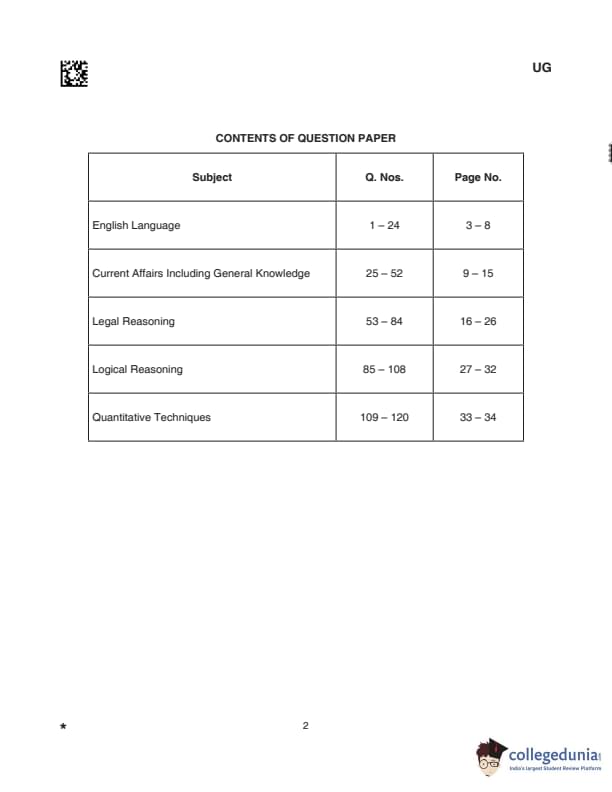
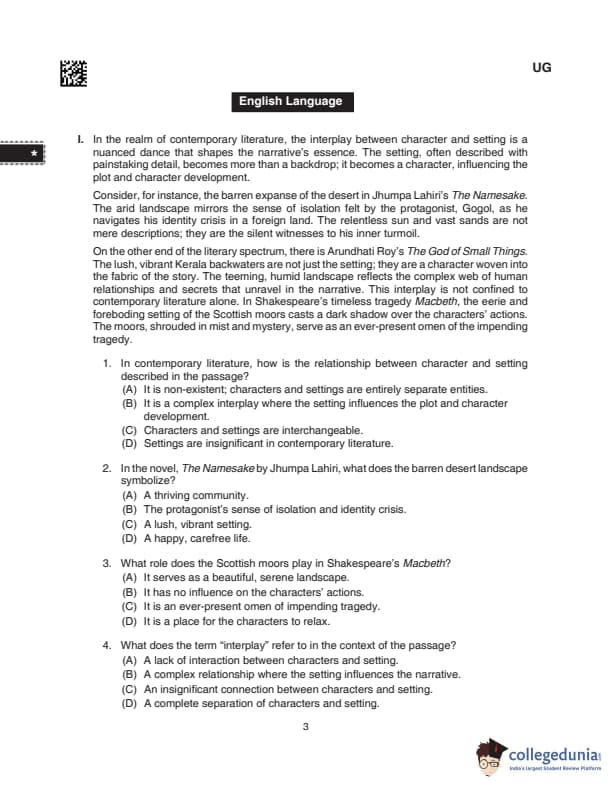
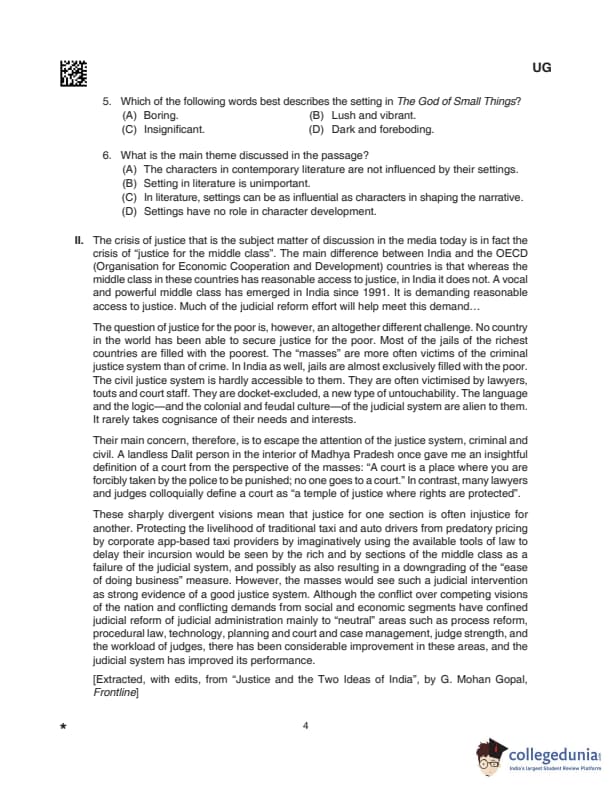
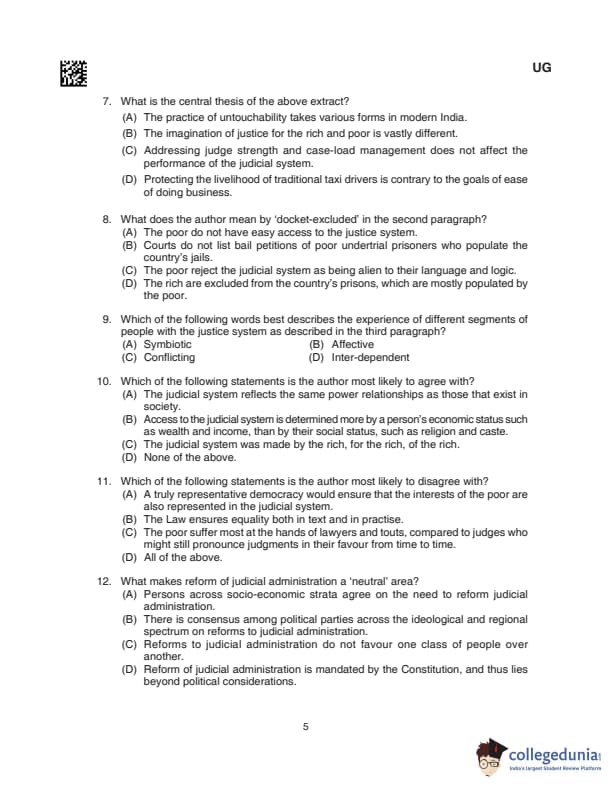
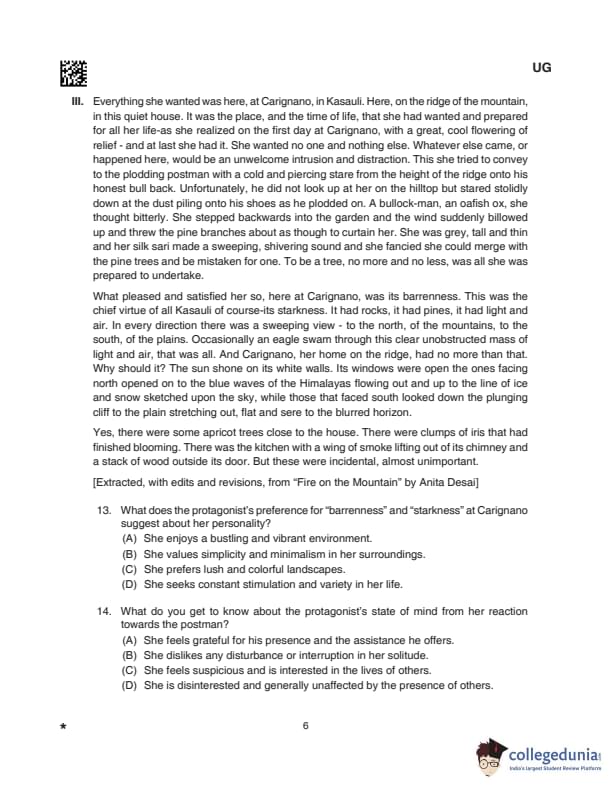

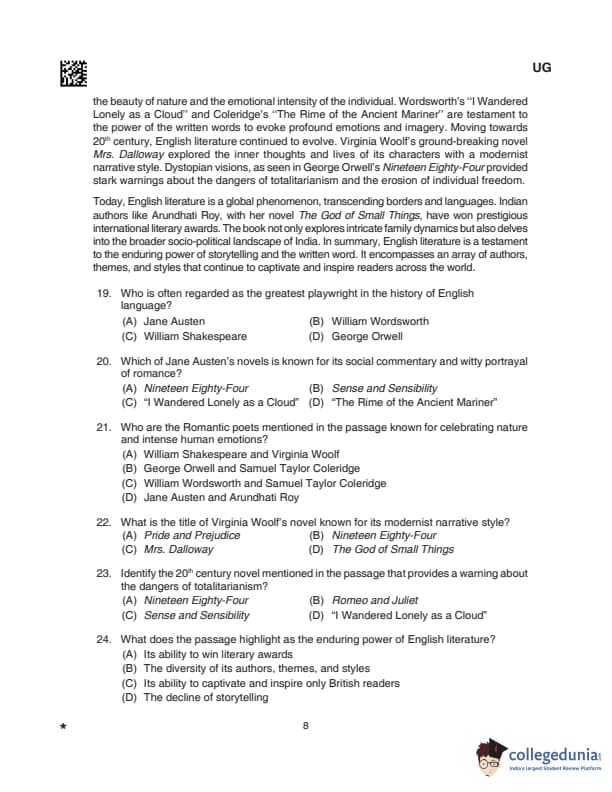
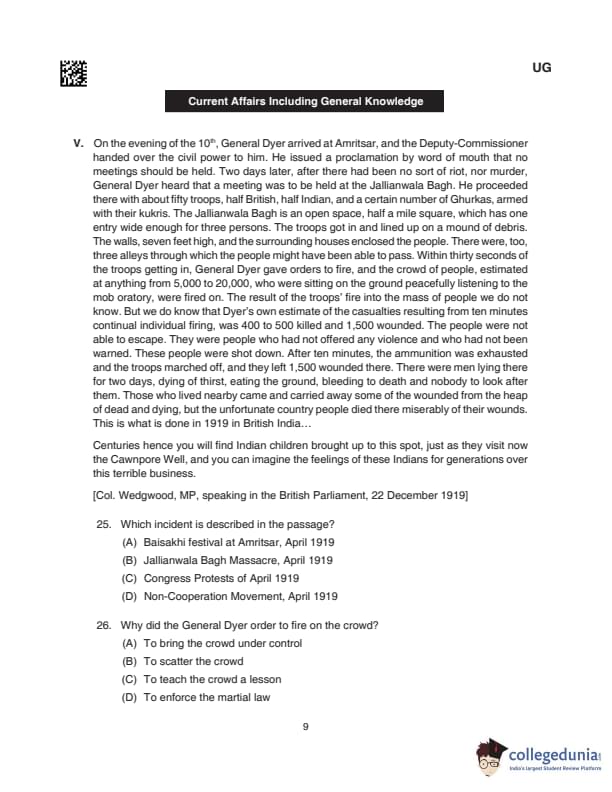

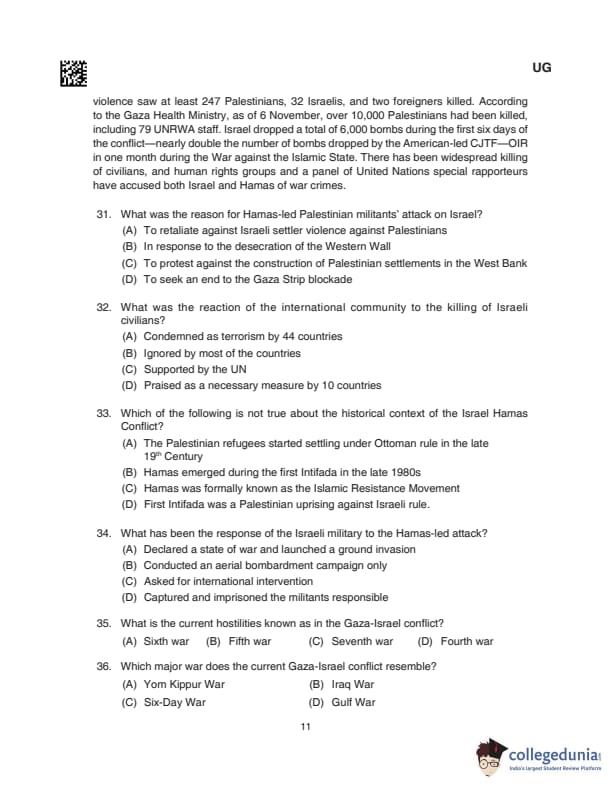
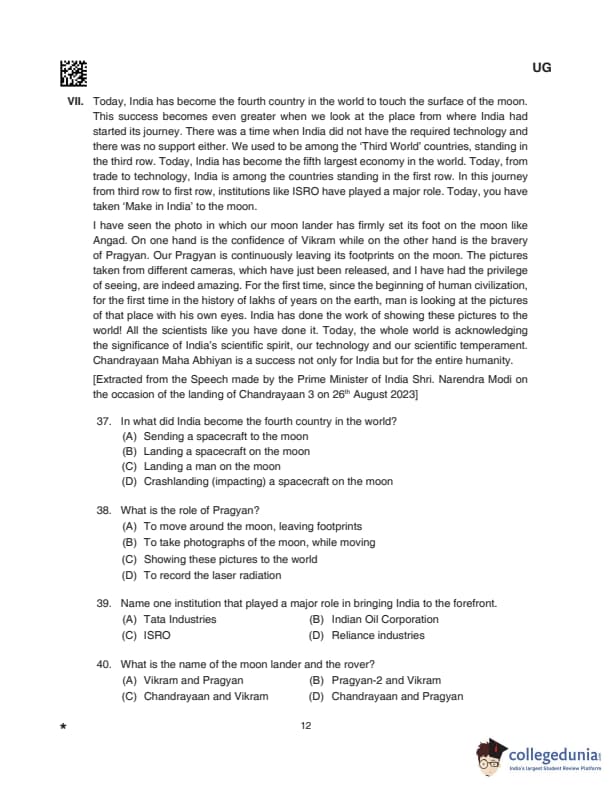

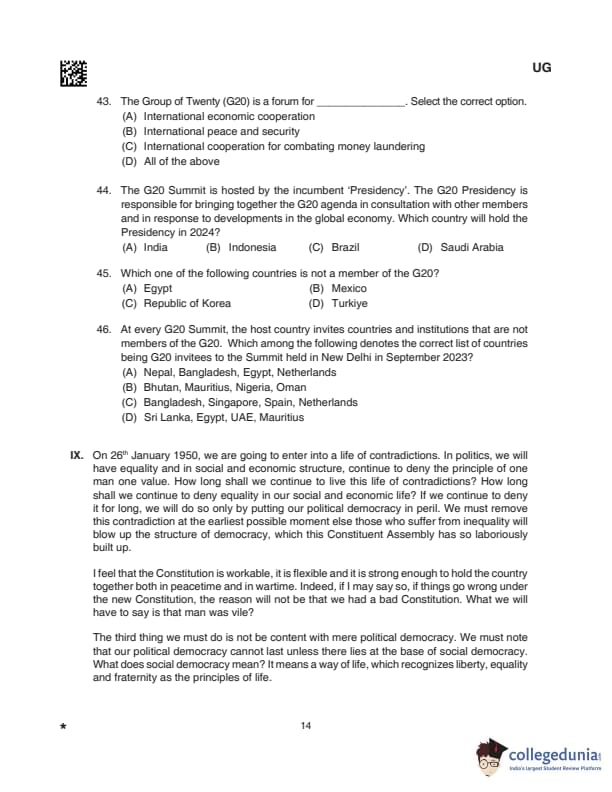
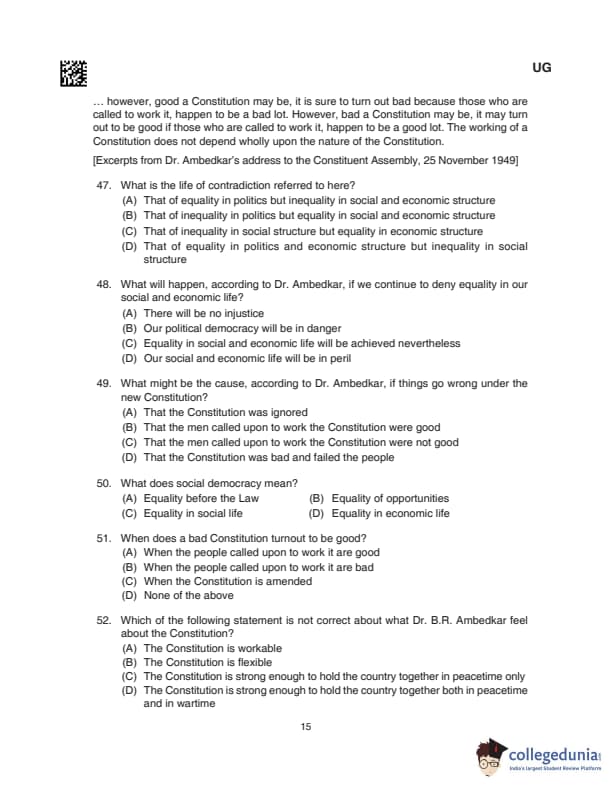

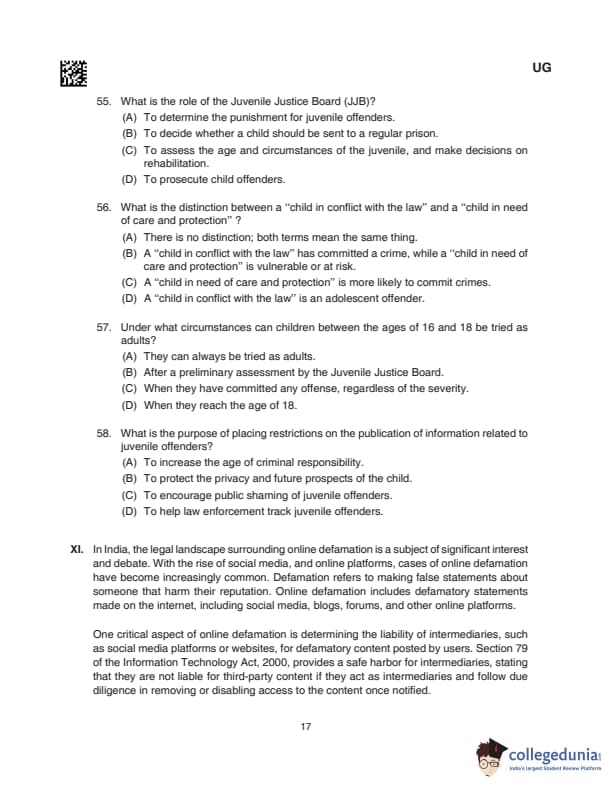

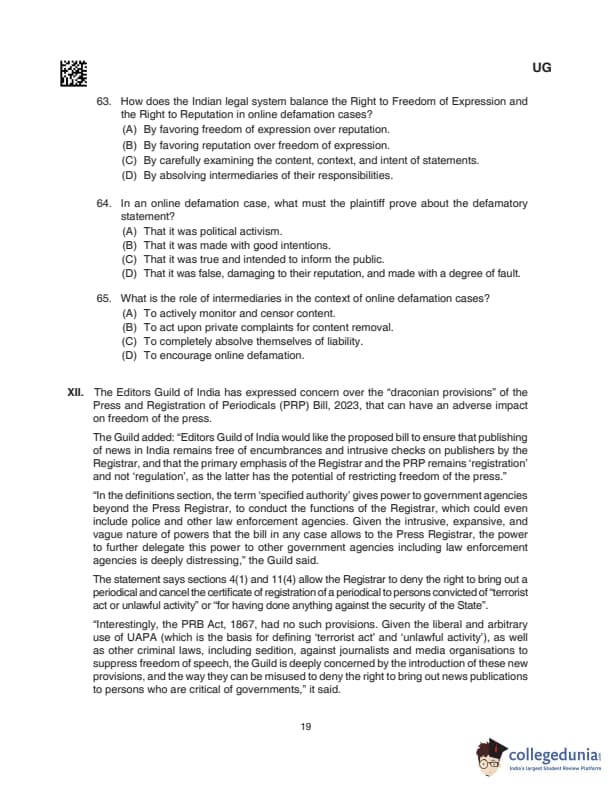
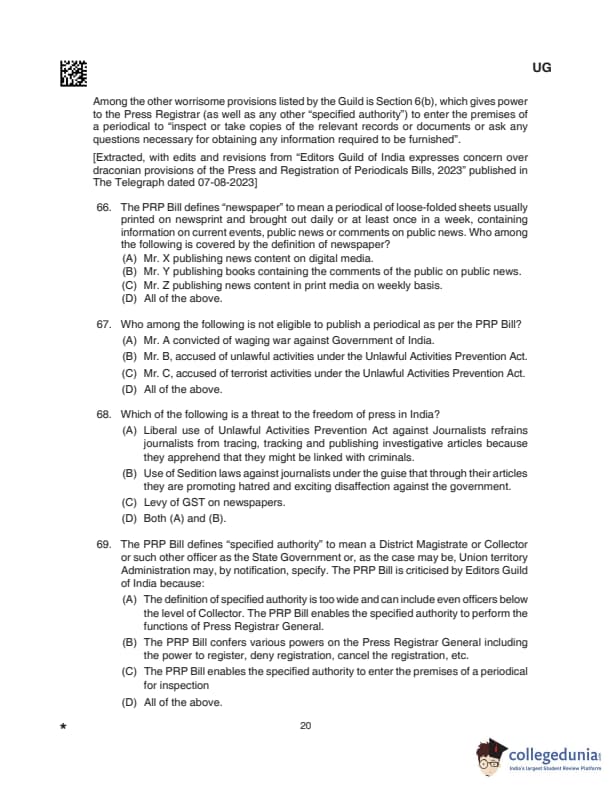

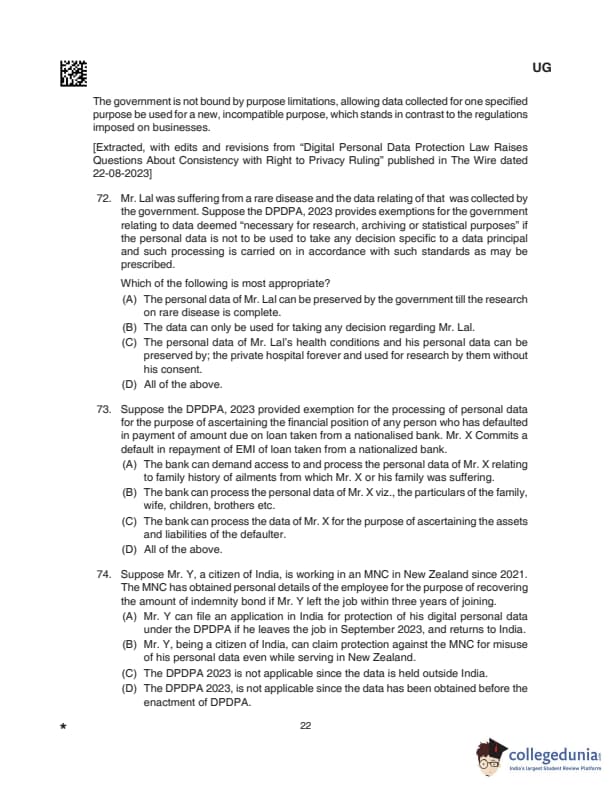

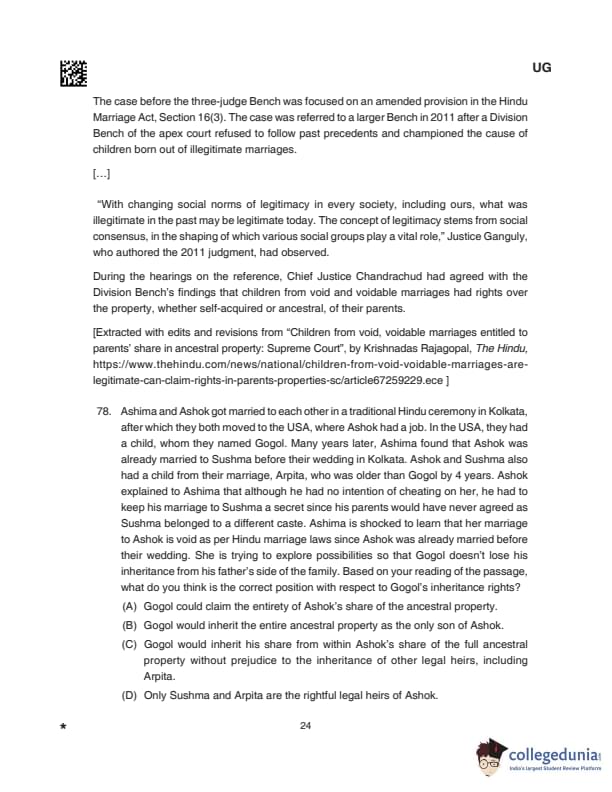
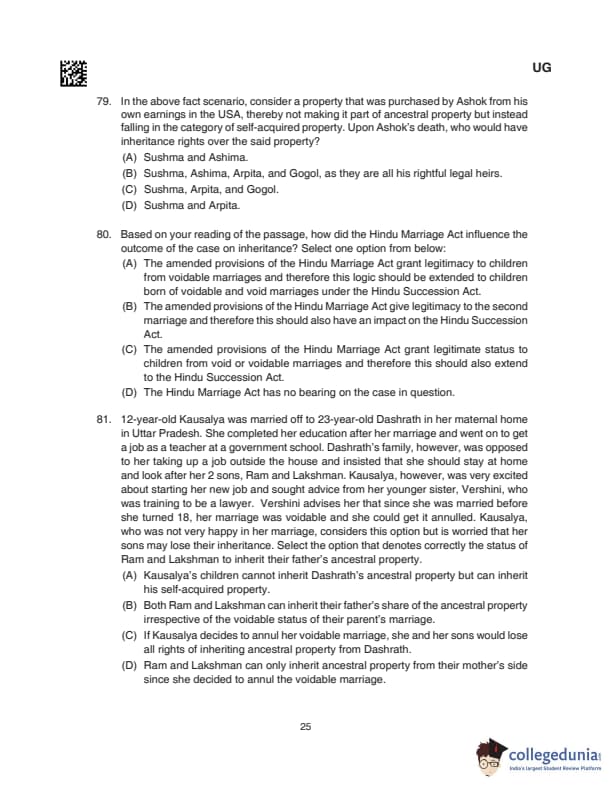

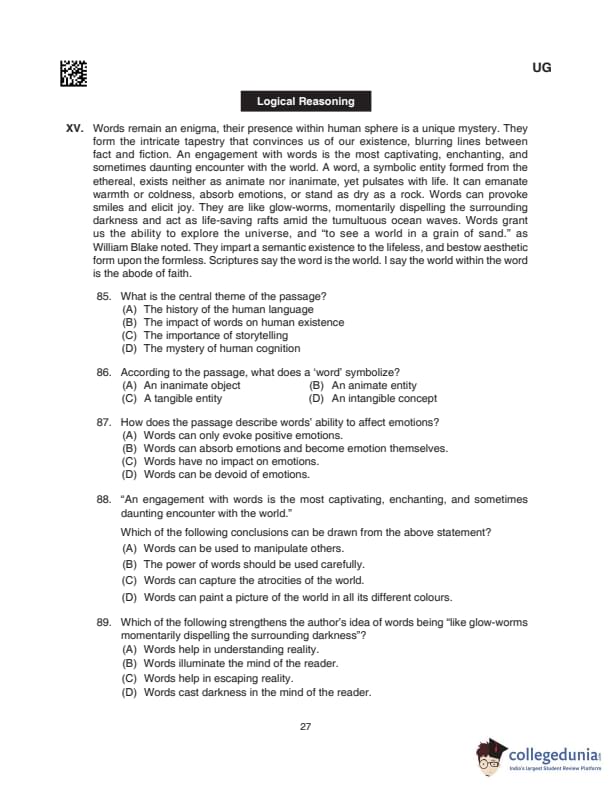
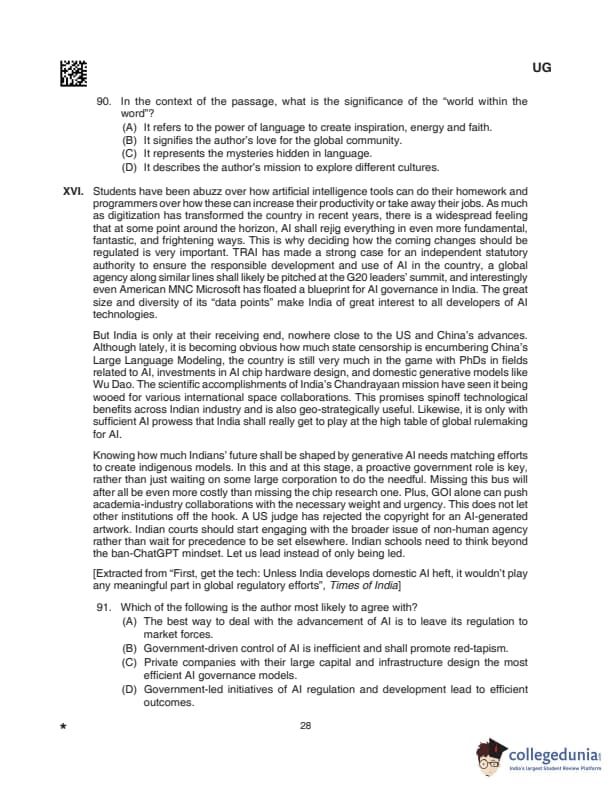
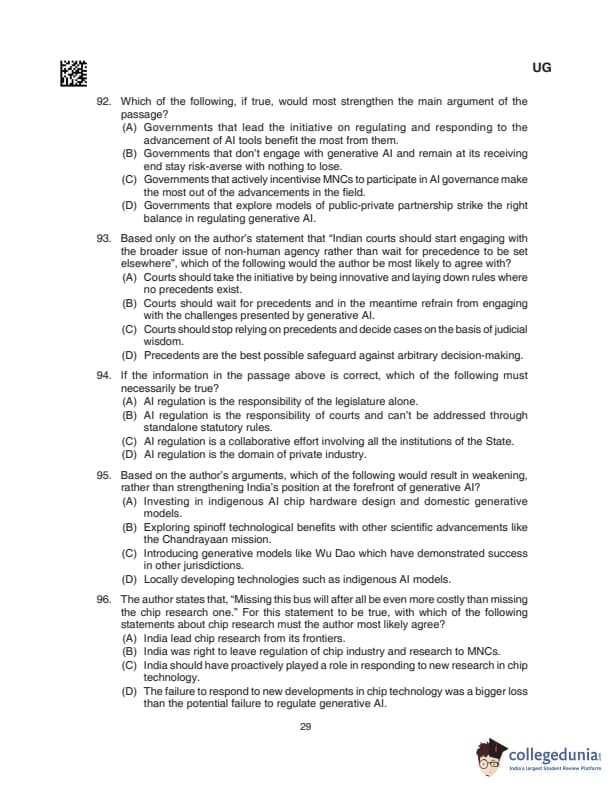
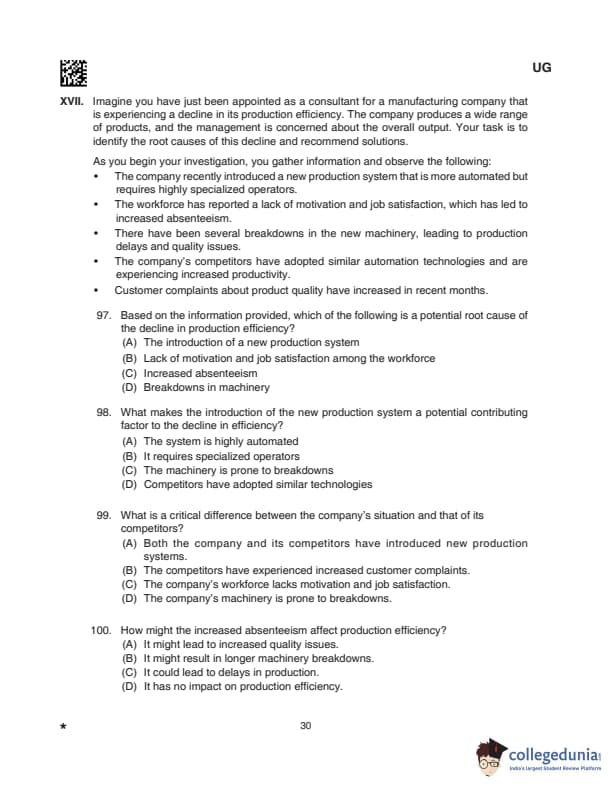
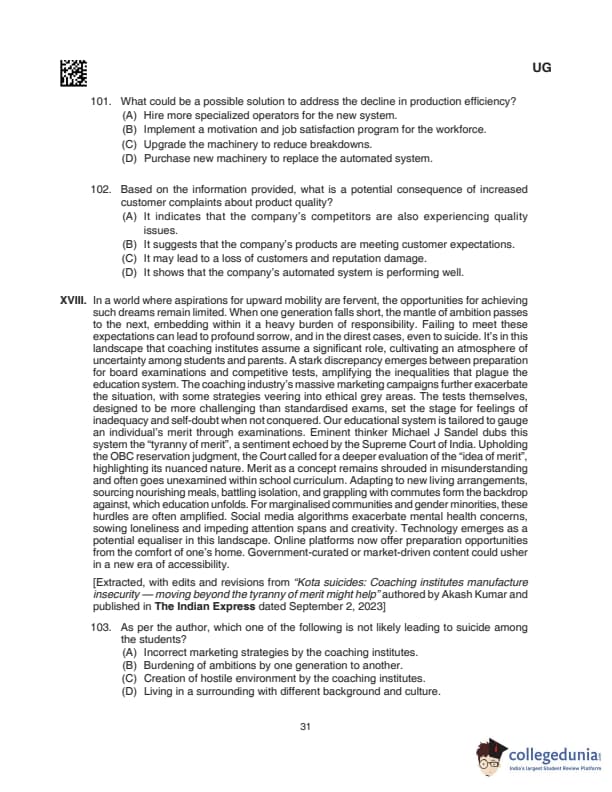
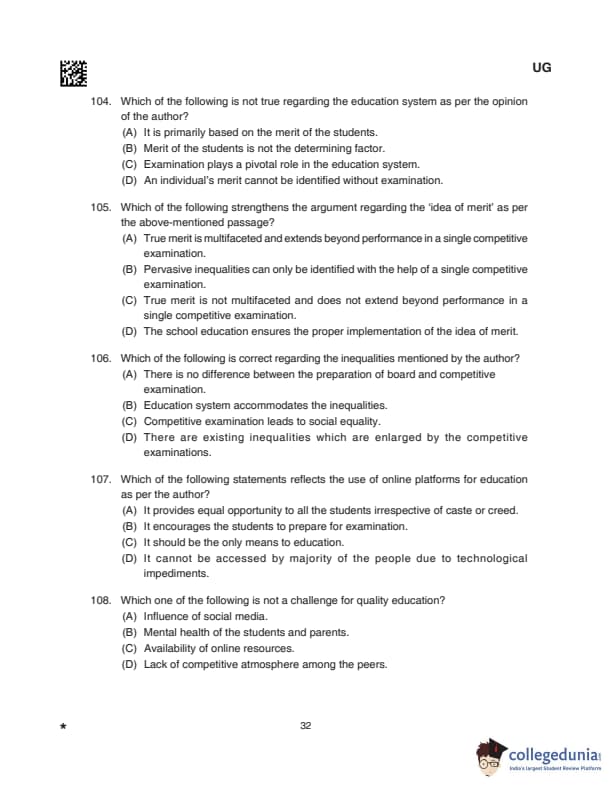
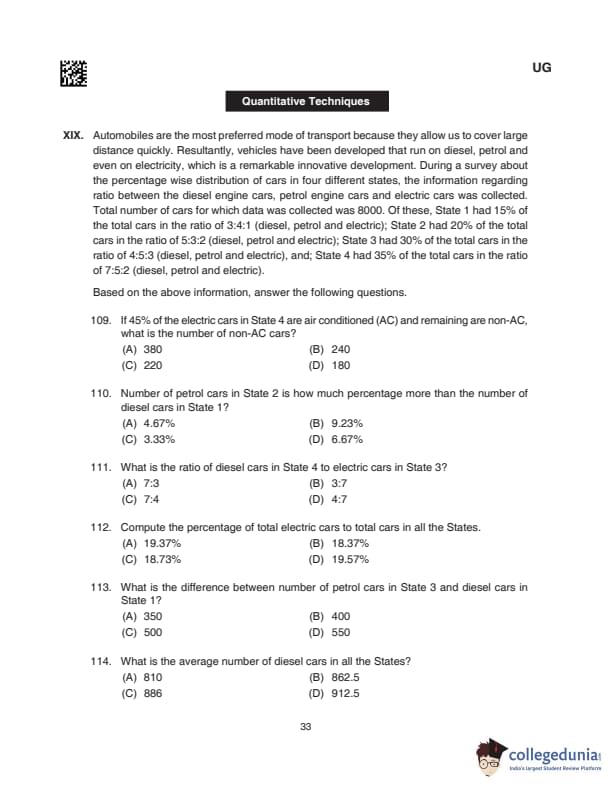
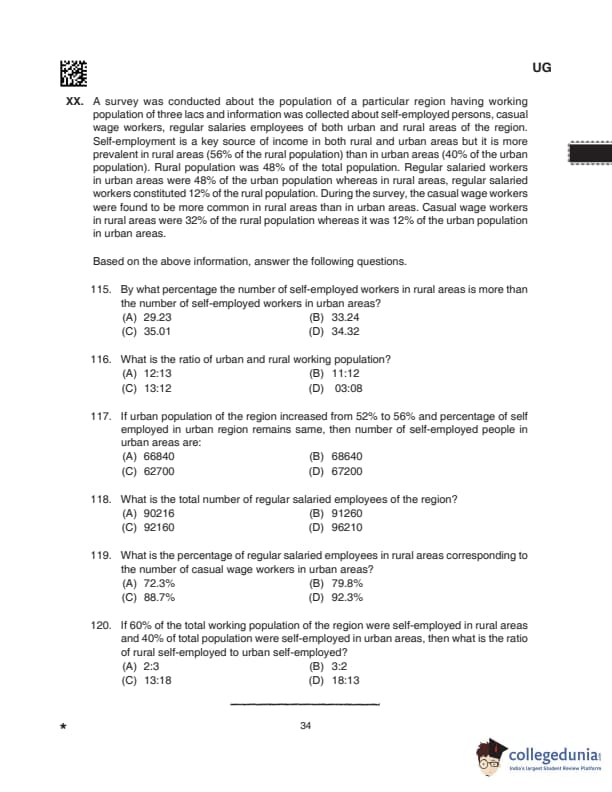
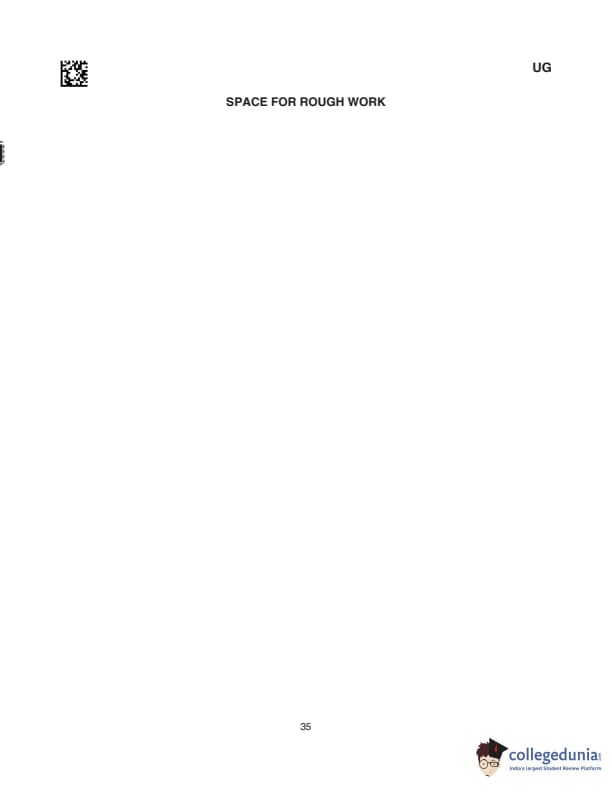
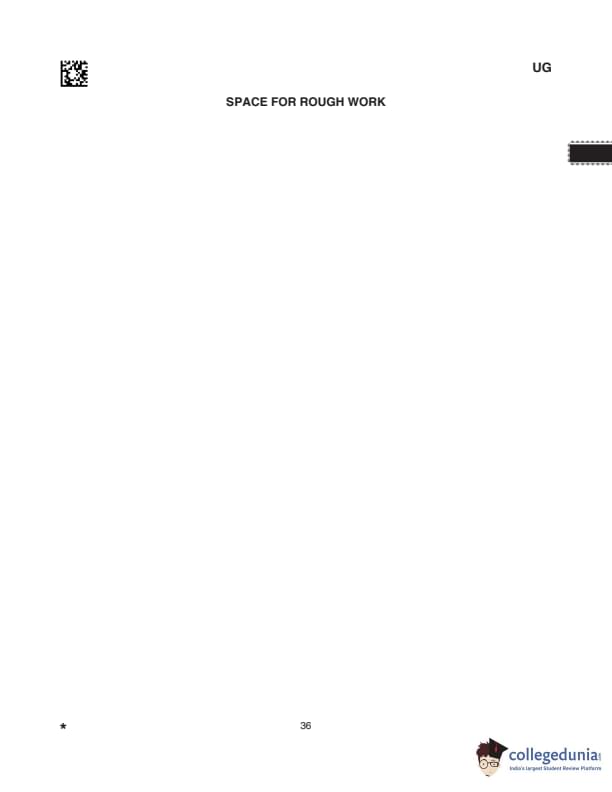


CLAT Questions
1. Students have been abuzz over how artificial intelligence tools can do their homework and programmers over how these can increase their productivity or take away their jobs. As much as digitization has transformed the country in recent years, there is a widespread feeling that at some point around the horizon, AI shall rejig everything in even more fundamental, fantastic, and frightening ways. This is why deciding how the coming changes should be regulated is very important. TRAI has made a strong case for an independent statutory authority to ensure the responsible development and use of AI in the country, a global agency along similar lines shall likely be pitched at the G20 leaders’ summit, and interestingly even American MNC Microsoft has floated a blueprint for AI governance in India. The great size and diversity of its “data points” make India of great interest to all developers of AI technologies.
But India is only at their receiving end, nowhere close to the US and China’s advances. Although lately, it is becoming obvious how much state censorship is encumbering China’s large language modeling, the country is still very much in the game with PhDs in fields related to AI, investments in AI chip hardware design, and domestic generative models like Wu Dao. The scientific accomplishments of India’s Chandrayaan mission have seen it being wooed for various international space collaborations. This promises spinoff technological benefits across Indian industry and is also geo-strategically useful. Likewise, it is only with sufficient AI prowess that India shall really get to play at the high table of global rulemaking for AI.
Knowing how much Indians’ future shall be shaped by generative AI needs matching efforts to create indigenous models. In this and at this stage, a proactive government role is key, rather than just waiting on some large corporation to do the needful. Missing this bus will after all be even more costly than missing the chip research one. Plus, GOI alone can push academia-industry collaborations with the necessary weight and urgency. This does not let other institutions off the hook. A US judge has rejected the copyright for an AI-generated artwork. Indian courts should start engaging with the broader issue of non-human agency rather than wait for precedence to be set elsewhere. Indian schools need to think beyond the ban-ChatGPT mindset. Let us lead instead of only being led.
[Extracted from “First, get the tech: Unless India develops domestic AI heft, it wouldn’t play any meaningful part in global regulatory efforts”, Times of India]
Students have been abuzz over how artificial intelligence tools can do their homework and programmers over how these can increase their productivity or take away their jobs. As much as digitization has transformed the country in recent years, there is a widespread feeling that at some point around the horizon, AI shall rejig everything in even more fundamental, fantastic, and frightening ways. This is why deciding how the coming changes should be regulated is very important. TRAI has made a strong case for an independent statutory authority to ensure the responsible development and use of AI in the country, a global agency along similar lines shall likely be pitched at the G20 leaders’ summit, and interestingly even American MNC Microsoft has floated a blueprint for AI governance in India. The great size and diversity of its “data points” make India of great interest to all developers of AI technologies.
But India is only at their receiving end, nowhere close to the US and China’s advances. Although lately, it is becoming obvious how much state censorship is encumbering China’s large language modeling, the country is still very much in the game with PhDs in fields related to AI, investments in AI chip hardware design, and domestic generative models like Wu Dao. The scientific accomplishments of India’s Chandrayaan mission have seen it being wooed for various international space collaborations. This promises spinoff technological benefits across Indian industry and is also geo-strategically useful. Likewise, it is only with sufficient AI prowess that India shall really get to play at the high table of global rulemaking for AI.
Knowing how much Indians’ future shall be shaped by generative AI needs matching efforts to create indigenous models. In this and at this stage, a proactive government role is key, rather than just waiting on some large corporation to do the needful. Missing this bus will after all be even more costly than missing the chip research one. Plus, GOI alone can push academia-industry collaborations with the necessary weight and urgency. This does not let other institutions off the hook. A US judge has rejected the copyright for an AI-generated artwork. Indian courts should start engaging with the broader issue of non-human agency rather than wait for precedence to be set elsewhere. Indian schools need to think beyond the ban-ChatGPT mindset. Let us lead instead of only being led.
[Extracted from “First, get the tech: Unless India develops domestic AI heft, it wouldn’t play any meaningful part in global regulatory efforts”, Times of India]
But India is only at their receiving end, nowhere close to the US and China’s advances. Although lately, it is becoming obvious how much state censorship is encumbering China’s large language modeling, the country is still very much in the game with PhDs in fields related to AI, investments in AI chip hardware design, and domestic generative models like Wu Dao. The scientific accomplishments of India’s Chandrayaan mission have seen it being wooed for various international space collaborations. This promises spinoff technological benefits across Indian industry and is also geo-strategically useful. Likewise, it is only with sufficient AI prowess that India shall really get to play at the high table of global rulemaking for AI.
Knowing how much Indians’ future shall be shaped by generative AI needs matching efforts to create indigenous models. In this and at this stage, a proactive government role is key, rather than just waiting on some large corporation to do the needful. Missing this bus will after all be even more costly than missing the chip research one. Plus, GOI alone can push academia-industry collaborations with the necessary weight and urgency. This does not let other institutions off the hook. A US judge has rejected the copyright for an AI-generated artwork. Indian courts should start engaging with the broader issue of non-human agency rather than wait for precedence to be set elsewhere. Indian schools need to think beyond the ban-ChatGPT mindset. Let us lead instead of only being led.
[Extracted from “First, get the tech: Unless India develops domestic AI heft, it wouldn’t play any meaningful part in global regulatory efforts”, Times of India]
2. The Editors Guild of India has expressed concern over the “draconian provisions” of the Press and Registration of Periodicals (PRP) Bill, 2023, that can have an adverse impact on freedom of the press.
The Guild added: “Editors Guild of India would like the proposed bill to ensure that publishing of news in India remains free of encumbrances and intrusive checks on publishers by the Registrar, and that the primary emphasis of the Registrar and the PRP remains ‘registration’ and not ‘regulation’, as the latter has the potential of restricting freedom of the press.”
“In the definitions section, the term ‘specified authority’ gives power to government agencies beyond the Press Registrar, to conduct the functions of the Registrar, which could even include police and other law enforcement agencies. Given the intrusive, expansive, and vague nature of powers that the bill in any case allows to the Press Registrar, the power to further delegate this power to other government agencies including law enforcement agencies is deeply distressing,” the Guild said.
The statement says sections 4(1) and 11(4) allow the Registrar to deny the right to bring out a periodical and cancel the certificate of registration of a periodical to persons convicted of “terrorist act or unlawful activity” or “for having done anything against the security of the State”.
“Interestingly, the PRB Act, 1867, had no such provisions. Given the liberal and arbitrary use of UAPA (which is the basis for defining ‘terrorist act’ and ‘unlawful activity’), as well as other criminal laws, including sedition, against journalists and media organisations to suppress freedom of speech, the Guild is deeply concerned by the introduction of these new provisions, and the way they can be misused to deny the right to bring out news publications to persons who are critical of governments,” it said.
Among the other worrisome provisions listed by the Guild is Section 6(b), which gives power to the Press Registrar (as well as any other “specified authority”) to enter the premises of a periodical to “inspect or take copies of the relevant records or documents or ask any questions necessary for obtaining any information required to be furnished”
[Extracted, with edits and revisions from “Editors Guild of India expresses concern over draconian provisions of the Press and Registration of Periodicals Bills, 2023” published in The Telegraph dated 07-08-2023]
The Editors Guild of India has expressed concern over the “draconian provisions” of the Press and Registration of Periodicals (PRP) Bill, 2023, that can have an adverse impact on freedom of the press.
The Guild added: “Editors Guild of India would like the proposed bill to ensure that publishing of news in India remains free of encumbrances and intrusive checks on publishers by the Registrar, and that the primary emphasis of the Registrar and the PRP remains ‘registration’ and not ‘regulation’, as the latter has the potential of restricting freedom of the press.”
“In the definitions section, the term ‘specified authority’ gives power to government agencies beyond the Press Registrar, to conduct the functions of the Registrar, which could even include police and other law enforcement agencies. Given the intrusive, expansive, and vague nature of powers that the bill in any case allows to the Press Registrar, the power to further delegate this power to other government agencies including law enforcement agencies is deeply distressing,” the Guild said.
The statement says sections 4(1) and 11(4) allow the Registrar to deny the right to bring out a periodical and cancel the certificate of registration of a periodical to persons convicted of “terrorist act or unlawful activity” or “for having done anything against the security of the State”.
“Interestingly, the PRB Act, 1867, had no such provisions. Given the liberal and arbitrary use of UAPA (which is the basis for defining ‘terrorist act’ and ‘unlawful activity’), as well as other criminal laws, including sedition, against journalists and media organisations to suppress freedom of speech, the Guild is deeply concerned by the introduction of these new provisions, and the way they can be misused to deny the right to bring out news publications to persons who are critical of governments,” it said.
Among the other worrisome provisions listed by the Guild is Section 6(b), which gives power to the Press Registrar (as well as any other “specified authority”) to enter the premises of a periodical to “inspect or take copies of the relevant records or documents or ask any questions necessary for obtaining any information required to be furnished”
[Extracted, with edits and revisions from “Editors Guild of India expresses concern over draconian provisions of the Press and Registration of Periodicals Bills, 2023” published in The Telegraph dated 07-08-2023]
The Guild added: “Editors Guild of India would like the proposed bill to ensure that publishing of news in India remains free of encumbrances and intrusive checks on publishers by the Registrar, and that the primary emphasis of the Registrar and the PRP remains ‘registration’ and not ‘regulation’, as the latter has the potential of restricting freedom of the press.”
“In the definitions section, the term ‘specified authority’ gives power to government agencies beyond the Press Registrar, to conduct the functions of the Registrar, which could even include police and other law enforcement agencies. Given the intrusive, expansive, and vague nature of powers that the bill in any case allows to the Press Registrar, the power to further delegate this power to other government agencies including law enforcement agencies is deeply distressing,” the Guild said.
The statement says sections 4(1) and 11(4) allow the Registrar to deny the right to bring out a periodical and cancel the certificate of registration of a periodical to persons convicted of “terrorist act or unlawful activity” or “for having done anything against the security of the State”.
“Interestingly, the PRB Act, 1867, had no such provisions. Given the liberal and arbitrary use of UAPA (which is the basis for defining ‘terrorist act’ and ‘unlawful activity’), as well as other criminal laws, including sedition, against journalists and media organisations to suppress freedom of speech, the Guild is deeply concerned by the introduction of these new provisions, and the way they can be misused to deny the right to bring out news publications to persons who are critical of governments,” it said.
Among the other worrisome provisions listed by the Guild is Section 6(b), which gives power to the Press Registrar (as well as any other “specified authority”) to enter the premises of a periodical to “inspect or take copies of the relevant records or documents or ask any questions necessary for obtaining any information required to be furnished”
[Extracted, with edits and revisions from “Editors Guild of India expresses concern over draconian provisions of the Press and Registration of Periodicals Bills, 2023” published in The Telegraph dated 07-08-2023]
3. The 18th G20 Summit, in which the heads of states and governments will meet, on September 9 and 10 will be held in India’s national capital New Delhi. Over 25 world leaders along with other delegates are going to attend this mega event.
One of the largest multilateral summits, the G20 Summit presents a significant diplomatic opportunity for India, which will convene with the adoption of a joint declaration by all the member states/
India assumed the G20 Presidency on December 1 last year. The 18th G20 Summit in New Delhi is scheduled to be held on September 9-10. ……
The Group of Twenty (G20) comprises 19 countries …. and the European Union. The G20 members represent around 85% of the global GDP, over 75% of the global trade, and about two-thirds of the world population.
World leaders from several countries and institutions will mark their presence at the event. They include US President Joe Biden, UK Prime Minister Rishi Sunak, Australian Prime Minister Anthony Albanese, Canadian Prime Minister Justin Trudeau and French President Emmanuel Macron.
However, Russian President Vladimir Putin has opted out of the summit and foreign minister Sergei Lavrov will represent the country in his place. Chinese President Xi Jinping has also decided to skip the event and will send country’s Premier Li Qiang instead, according to sources.
The G20 Summit 2023 is being held under the theme – Vasudhaiva Kutumbakam (One Earth. One Family. One Future) – centered around the value of all life including human, animal, plant, and microorganisms and their interconnectedness on the planet Earth and in the wider universe.
India’s presidency of the summit holds significance as it aims to become a voice for the ‘less developed’ global South in a world dominated by developed nations of the West. It is also likely to take up the issue of border tension with China. India, for its part, may attempt to straighten out its diplomatic intricacies with the West after it faced challenges due to the Russia-Ukraine conflict. [Extracted, with edits and revisions, from “India gears up for G20 Summit: Check event venue, guest list, special invitees”, Hindustan Times]
The 18th G20 Summit, in which the heads of states and governments will meet, on September 9 and 10 will be held in India’s national capital New Delhi. Over 25 world leaders along with other delegates are going to attend this mega event.
One of the largest multilateral summits, the G20 Summit presents a significant diplomatic opportunity for India, which will convene with the adoption of a joint declaration by all the member states/
India assumed the G20 Presidency on December 1 last year. The 18th G20 Summit in New Delhi is scheduled to be held on September 9-10. ……
The Group of Twenty (G20) comprises 19 countries …. and the European Union. The G20 members represent around 85% of the global GDP, over 75% of the global trade, and about two-thirds of the world population.
World leaders from several countries and institutions will mark their presence at the event. They include US President Joe Biden, UK Prime Minister Rishi Sunak, Australian Prime Minister Anthony Albanese, Canadian Prime Minister Justin Trudeau and French President Emmanuel Macron.
However, Russian President Vladimir Putin has opted out of the summit and foreign minister Sergei Lavrov will represent the country in his place. Chinese President Xi Jinping has also decided to skip the event and will send country’s Premier Li Qiang instead, according to sources.
The G20 Summit 2023 is being held under the theme – Vasudhaiva Kutumbakam (One Earth. One Family. One Future) – centered around the value of all life including human, animal, plant, and microorganisms and their interconnectedness on the planet Earth and in the wider universe.
India’s presidency of the summit holds significance as it aims to become a voice for the ‘less developed’ global South in a world dominated by developed nations of the West. It is also likely to take up the issue of border tension with China. India, for its part, may attempt to straighten out its diplomatic intricacies with the West after it faced challenges due to the Russia-Ukraine conflict. [Extracted, with edits and revisions, from “India gears up for G20 Summit: Check event venue, guest list, special invitees”, Hindustan Times]
One of the largest multilateral summits, the G20 Summit presents a significant diplomatic opportunity for India, which will convene with the adoption of a joint declaration by all the member states/
India assumed the G20 Presidency on December 1 last year. The 18th G20 Summit in New Delhi is scheduled to be held on September 9-10. ……
The Group of Twenty (G20) comprises 19 countries …. and the European Union. The G20 members represent around 85% of the global GDP, over 75% of the global trade, and about two-thirds of the world population.
World leaders from several countries and institutions will mark their presence at the event. They include US President Joe Biden, UK Prime Minister Rishi Sunak, Australian Prime Minister Anthony Albanese, Canadian Prime Minister Justin Trudeau and French President Emmanuel Macron.
However, Russian President Vladimir Putin has opted out of the summit and foreign minister Sergei Lavrov will represent the country in his place. Chinese President Xi Jinping has also decided to skip the event and will send country’s Premier Li Qiang instead, according to sources.
The G20 Summit 2023 is being held under the theme – Vasudhaiva Kutumbakam (One Earth. One Family. One Future) – centered around the value of all life including human, animal, plant, and microorganisms and their interconnectedness on the planet Earth and in the wider universe.
India’s presidency of the summit holds significance as it aims to become a voice for the ‘less developed’ global South in a world dominated by developed nations of the West. It is also likely to take up the issue of border tension with China. India, for its part, may attempt to straighten out its diplomatic intricacies with the West after it faced challenges due to the Russia-Ukraine conflict. [Extracted, with edits and revisions, from “India gears up for G20 Summit: Check event venue, guest list, special invitees”, Hindustan Times]
4. Imagine you have just been appointed as a consultant for a manufacturing company that is experiencing a decline in its production efficiency. The company produces a wide range of products, and the management is concerned about the overall output. Your task is to identify the root causes of this decline and recommend solutions.
As you begin your investigation, you gather information and observe the following:
• The company recently introduced a new production system that is more automated but requires highly specialized operators.
• The workforce has reported a lack of motivation and job satisfaction, which has led to increased absenteeism.
• There have been several breakdowns in the new machinery, leading to production delays and quality issues.
• The company’s competitors have adopted similar automation technologies and are experiencing increased productivity.
• Customer complaints about product quality have increased in recent months.
Imagine you have just been appointed as a consultant for a manufacturing company that is experiencing a decline in its production efficiency. The company produces a wide range of products, and the management is concerned about the overall output. Your task is to identify the root causes of this decline and recommend solutions.
As you begin your investigation, you gather information and observe the following:
• The company recently introduced a new production system that is more automated but requires highly specialized operators.
• The workforce has reported a lack of motivation and job satisfaction, which has led to increased absenteeism.
• There have been several breakdowns in the new machinery, leading to production delays and quality issues.
• The company’s competitors have adopted similar automation technologies and are experiencing increased productivity.
• Customer complaints about product quality have increased in recent months.
As you begin your investigation, you gather information and observe the following:
• The company recently introduced a new production system that is more automated but requires highly specialized operators.
• The workforce has reported a lack of motivation and job satisfaction, which has led to increased absenteeism.
• There have been several breakdowns in the new machinery, leading to production delays and quality issues.
• The company’s competitors have adopted similar automation technologies and are experiencing increased productivity.
• Customer complaints about product quality have increased in recent months.
5. Today, India has become the fourth country in the world to touch the surface of the moon. This success becomes even greater when we look at the place from where India had started its journey. There was a time when India did not have the required technology and there was no support either. We used to be among the ‘Third World’ countries, standing in the third row. Today, India has become the fifth largest economy in the world. Today, from trade to technology, India is among the countries standing in the first row. In this journey from third row to first row, institutions like ISRO have played a major role. Today, you have taken ‘Make in India’ to the moon.
I have seen the photo in which our moon lander has firmly set its foot on the moon like Angad. On one hand is the confidence of Vikram while on the other hand is the bravery of Pragyan. Our Pragyan is continuously leaving its footprints on the moon. The pictures taken from different cameras, which have just been released, and I have had the privilege of seeing, are indeed amazing. For the first time, since the beginning of human civilization, for the first time in the history of lakhs of years on the earth, man is looking at the pictures of that place with his own eyes. India has done the work of showing these pictures to the world! All the scientists like you have done it. Today, the whole world is acknowledging the significance of India’s scientific spirit, our technology and our scientific temperament. Chandrayaan Maha Abhiyan is a success not only for India but for the entire humanity.
[Extracted from the Speech made by the Prime Minister of India Shri. Narendra Modi on the occasion of the landing of Chandrayaan 3 on 26th August 2023]
Today, India has become the fourth country in the world to touch the surface of the moon. This success becomes even greater when we look at the place from where India had started its journey. There was a time when India did not have the required technology and there was no support either. We used to be among the ‘Third World’ countries, standing in the third row. Today, India has become the fifth largest economy in the world. Today, from trade to technology, India is among the countries standing in the first row. In this journey from third row to first row, institutions like ISRO have played a major role. Today, you have taken ‘Make in India’ to the moon.
I have seen the photo in which our moon lander has firmly set its foot on the moon like Angad. On one hand is the confidence of Vikram while on the other hand is the bravery of Pragyan. Our Pragyan is continuously leaving its footprints on the moon. The pictures taken from different cameras, which have just been released, and I have had the privilege of seeing, are indeed amazing. For the first time, since the beginning of human civilization, for the first time in the history of lakhs of years on the earth, man is looking at the pictures of that place with his own eyes. India has done the work of showing these pictures to the world! All the scientists like you have done it. Today, the whole world is acknowledging the significance of India’s scientific spirit, our technology and our scientific temperament. Chandrayaan Maha Abhiyan is a success not only for India but for the entire humanity.
[Extracted from the Speech made by the Prime Minister of India Shri. Narendra Modi on the occasion of the landing of Chandrayaan 3 on 26th August 2023]
I have seen the photo in which our moon lander has firmly set its foot on the moon like Angad. On one hand is the confidence of Vikram while on the other hand is the bravery of Pragyan. Our Pragyan is continuously leaving its footprints on the moon. The pictures taken from different cameras, which have just been released, and I have had the privilege of seeing, are indeed amazing. For the first time, since the beginning of human civilization, for the first time in the history of lakhs of years on the earth, man is looking at the pictures of that place with his own eyes. India has done the work of showing these pictures to the world! All the scientists like you have done it. Today, the whole world is acknowledging the significance of India’s scientific spirit, our technology and our scientific temperament. Chandrayaan Maha Abhiyan is a success not only for India but for the entire humanity.
[Extracted from the Speech made by the Prime Minister of India Shri. Narendra Modi on the occasion of the landing of Chandrayaan 3 on 26th August 2023]
6. On 7th October 2023, an armed conflict broke out between Israel and Hamas-led Palestinian militants from the Gaza Strip[o] after the latter launched a multi-pronged invasion of southern Israel. After clearing Hamas militants, the Israeli military retaliated by conducting an extensive aerial bombardment campaign on Gazan targets and followed up with a largescale ground invasion of Gaza. More than 1,400 Israelis, mostly civilians, and more than 10,000 Palestinians have been killed in the fighting. Over 240 Israelis and foreign nationals were taken hostage and brought into the Gaza Strip.
The Hamas-led attack began in the morning of 7th October, as Palestinian militants in Gaza launched a barrage of over 5,000 rockets against Israeli cities and kibbutzim while some 3,000 Palestinian militants breached the Gaza-Israel barrier. Over 1,000 Israeli civilians were killed in more than a dozen massacres, including the Re’im music festival massacre, and military bases were attacked. Over 200 civilians and Israeli soldiers were captured or abducted and taken to the Gaza Strip. At least 44 countries, mostly from the Western world, characterized the massacres of civilians as terrorism. Hamas declared that the invasion was carried out in response to the ‘‘desecration of the Al-Aqsa Mosque’’, the Gaza Strip blockade, the construction of Israeli settlements, and Israeli settler violence against Palestinians in the West Bank.
Israel declared a state of war on 8th October, and its response to the attack has seen the most significant military escalation in the region since the Yom Kippur War. The current hostilities constitute the fifth war of the Gaza–Israel conflict, which is part of the broader Israeli– Palestinian conflict. In 2023, before the offensive started, an uptick in Israeli–Palestinian 11 * UG violence saw at least 247 Palestinians, 32 Israelis, and two foreigners killed. According to the Gaza Health Ministry, as of 6 November, over 10,000 Palestinians had been killed, including 79 UNRWA staff. Israel dropped a total of 6,000 bombs during the first six days of the conflict—nearly double the number of bombs dropped by the American-led CJTF—OIR in one month during the War against the Islamic State. There has been widespread killing of civilians, and human rights groups and a panel of United Nations special rapporteurs have accused both Israel and Hamas of war crimes.
On 7th October 2023, an armed conflict broke out between Israel and Hamas-led Palestinian militants from the Gaza Strip[o] after the latter launched a multi-pronged invasion of southern Israel. After clearing Hamas militants, the Israeli military retaliated by conducting an extensive aerial bombardment campaign on Gazan targets and followed up with a largescale ground invasion of Gaza. More than 1,400 Israelis, mostly civilians, and more than 10,000 Palestinians have been killed in the fighting. Over 240 Israelis and foreign nationals were taken hostage and brought into the Gaza Strip.
The Hamas-led attack began in the morning of 7th October, as Palestinian militants in Gaza launched a barrage of over 5,000 rockets against Israeli cities and kibbutzim while some 3,000 Palestinian militants breached the Gaza-Israel barrier. Over 1,000 Israeli civilians were killed in more than a dozen massacres, including the Re’im music festival massacre, and military bases were attacked. Over 200 civilians and Israeli soldiers were captured or abducted and taken to the Gaza Strip. At least 44 countries, mostly from the Western world, characterized the massacres of civilians as terrorism. Hamas declared that the invasion was carried out in response to the ‘‘desecration of the Al-Aqsa Mosque’’, the Gaza Strip blockade, the construction of Israeli settlements, and Israeli settler violence against Palestinians in the West Bank.
Israel declared a state of war on 8th October, and its response to the attack has seen the most significant military escalation in the region since the Yom Kippur War. The current hostilities constitute the fifth war of the Gaza–Israel conflict, which is part of the broader Israeli– Palestinian conflict. In 2023, before the offensive started, an uptick in Israeli–Palestinian 11 * UG violence saw at least 247 Palestinians, 32 Israelis, and two foreigners killed. According to the Gaza Health Ministry, as of 6 November, over 10,000 Palestinians had been killed, including 79 UNRWA staff. Israel dropped a total of 6,000 bombs during the first six days of the conflict—nearly double the number of bombs dropped by the American-led CJTF—OIR in one month during the War against the Islamic State. There has been widespread killing of civilians, and human rights groups and a panel of United Nations special rapporteurs have accused both Israel and Hamas of war crimes.
The Hamas-led attack began in the morning of 7th October, as Palestinian militants in Gaza launched a barrage of over 5,000 rockets against Israeli cities and kibbutzim while some 3,000 Palestinian militants breached the Gaza-Israel barrier. Over 1,000 Israeli civilians were killed in more than a dozen massacres, including the Re’im music festival massacre, and military bases were attacked. Over 200 civilians and Israeli soldiers were captured or abducted and taken to the Gaza Strip. At least 44 countries, mostly from the Western world, characterized the massacres of civilians as terrorism. Hamas declared that the invasion was carried out in response to the ‘‘desecration of the Al-Aqsa Mosque’’, the Gaza Strip blockade, the construction of Israeli settlements, and Israeli settler violence against Palestinians in the West Bank.
Israel declared a state of war on 8th October, and its response to the attack has seen the most significant military escalation in the region since the Yom Kippur War. The current hostilities constitute the fifth war of the Gaza–Israel conflict, which is part of the broader Israeli– Palestinian conflict. In 2023, before the offensive started, an uptick in Israeli–Palestinian 11 * UG violence saw at least 247 Palestinians, 32 Israelis, and two foreigners killed. According to the Gaza Health Ministry, as of 6 November, over 10,000 Palestinians had been killed, including 79 UNRWA staff. Israel dropped a total of 6,000 bombs during the first six days of the conflict—nearly double the number of bombs dropped by the American-led CJTF—OIR in one month during the War against the Islamic State. There has been widespread killing of civilians, and human rights groups and a panel of United Nations special rapporteurs have accused both Israel and Hamas of war crimes.










Comments